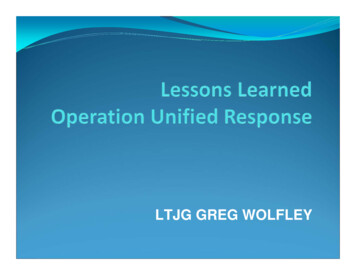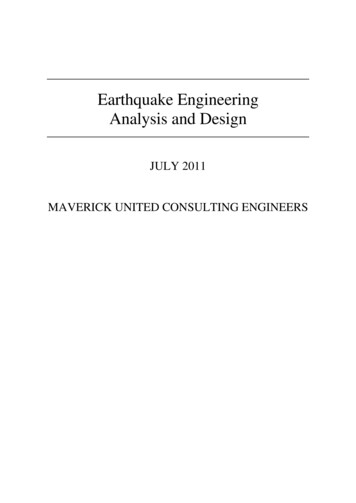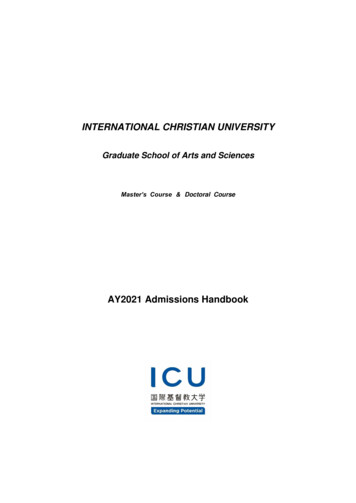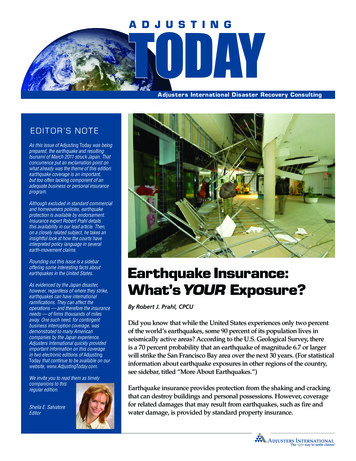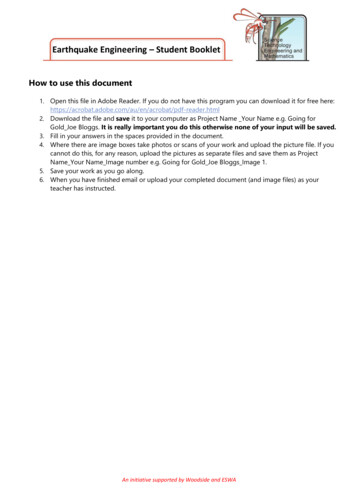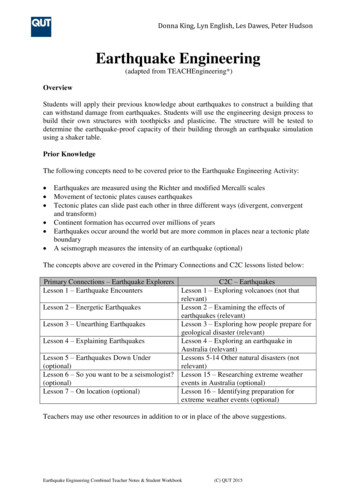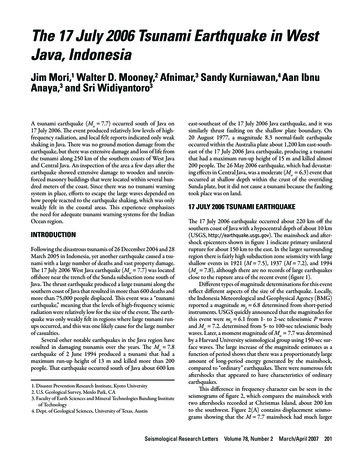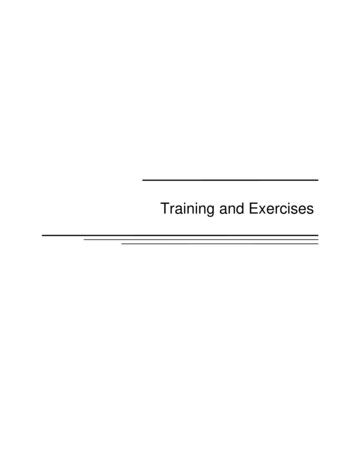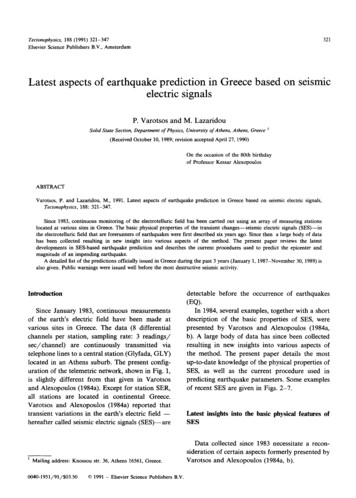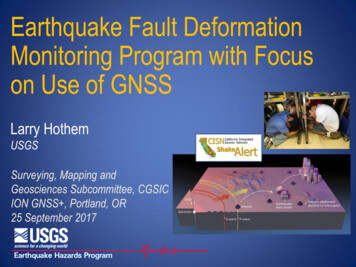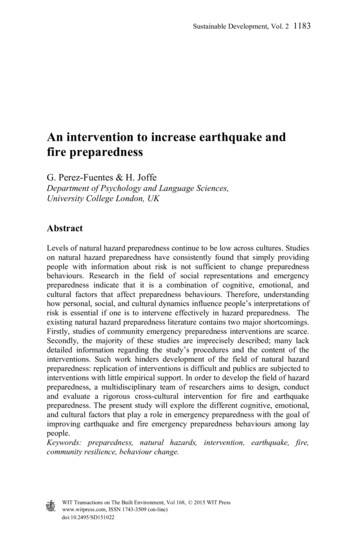
Transcription
Sustainable Development, Vol. 21183An intervention to increase earthquake andfire preparednessG. Perez-Fuentes & H. JoffeDepartment of Psychology and Language Sciences,University College London, UKAbstractLevels of natural hazard preparedness continue to be low across cultures. Studieson natural hazard preparedness have consistently found that simply providingpeople with information about risk is not sufficient to change preparednessbehaviours. Research in the field of social representations and emergencypreparedness indicate that it is a combination of cognitive, emotional, andcultural factors that affect preparedness behaviours. Therefore, understandinghow personal, social, and cultural dynamics influence people’s interpretations ofrisk is essential if one is to intervene effectively in hazard preparedness. Theexisting natural hazard preparedness literature contains two major shortcomings.Firstly, studies of community emergency preparedness interventions are scarce.Secondly, the majority of these studies are imprecisely described; many lackdetailed information regarding the study’s procedures and the content of theinterventions. Such work hinders development of the field of natural hazardpreparedness: replication of interventions is difficult and publics are subjected tointerventions with little empirical support. In order to develop the field of hazardpreparedness, a multidisciplinary team of researchers aims to design, conductand evaluate a rigorous cross-cultural intervention for fire and earthquakepreparedness. The present study will explore the different cognitive, emotional,and cultural factors that play a role in emergency preparedness with the goal ofimproving earthquake and fire emergency preparedness behaviours among laypeople.Keywords: preparedness, natural hazards, intervention, earthquake, fire,community resilience, behaviour change.WIT Transactions on The Built Environment, Vol 168, 2015 WIT Presswww.witpress.com, ISSN 1743-3509 (on-line)doi:10.2495/SD151022
1184 Sustainable Development, Vol. 21 IntroductionIt is critical to adopt and maintain preparedness measures at the household levelif risk of injury and damage at home is to be reduced. Such measures alsominimise the disruption that follows a natural disaster. Disaster preparednessmeasures range from securing heavy objects, structural retrofitting, and storingfood and water, to having communication and evacuation plans. It is known thata prepared community recovers faster and more effective after a disaster (Miletiet al. [1]). This, in turn, translates into a more resilient public that is able toeffectively respond before, during, and after the disaster (Lindell et al. [2]).Preparedness or readiness thus constitutes the first phase of resilience. In a worldwhere globalization, gentrification, and climate change are rapidly increasing,the building of resilience is critical.While it is in people’s best interests to make safety-related plans before adisaster occurs, the existing literature shows that most people are not preparedfor action in emergency situations [3–9]. Even people who live in areas wherenatural disasters occur frequently are not prepared [10–14]. Authorities havefrequently attributed the lack of preparedness among communities to a lack ofinformation. Thus, according to this model, sometimes termed the deficit model[15–19], it is often believed that the provision of hazards information to thepublic encourages preparation. Nonetheless, studies have consistently found thatmerely providing people with information about risks and their consequences isnot sufficient to affect preparedness behaviours [4–6, 20–22]. Furthermore,previous experience with natural disasters has not been found to be a goodpredictor of preparedness [12, 23–29]. Hence, simply being aware of the risk, inparticular earthquake risk does not increase the propensity to undertakeprotective behaviours (Solberg et al. [30]).In the past years, research has attempted to understand what influences andpredicts people’s preparedness behaviours [5, 6, 21, 31]. A few studies havefocused their efforts on interventions to improve preparedness behaviours at thehousehold level, with little success. In addition, their procedures and methods areimprecisely described and evaluated. This paper summarizes a review of currentcommunity interventions on earthquake and fire preparedness, and thendescribes our Challenging Risk project, a multidisciplinary, cross-cultural,community intervention for earthquake and fire preparedness.2 The social psychological literature on naturalhazard preparednessThe psychology of risk field has increasingly accepted that perceptions areinfluenced by emotional and sociocultural factors [32], rather than purelyrational factors; such perceptions then drive behaviour [10]. Along with the hostof cognitive biases that colour risk perception stands a wide range of emotionaland sociocultural factors (e.g., anxiety, trust and fatalism) that mediate theexecution of preparedness actions.WIT Transactions on The Built Environment, Vol 168, 2015 WIT Presswww.witpress.com, ISSN 1743-3509 (on-line)
Sustainable Development, Vol. 211852.1 Predictors of preparednessCognitive biases, such as optimistic bias, where people believe that they are lessat risk of being affected by a danger when compared to others, or normalizationbias, which postulates that people who experience little or no harm in anearthquake are less likely to heed future earthquake warnings, affect how risk isperceived by the public and hinder preparedness [10, 24, 33]. By way of contrastthe following have been reported to be good predictors of preparedness:behavioural intention [20, 34], perceived self-efficacy [31], collective efficacy[31], empowerment [31], perceived outcome expectancy [31], critical awareness[21, 31], social cohesion [21, 35, 36], sense of community [9, 37], communityparticipation [21, 31, 35, 36, 38, 39], and trust in the authorities [31, 40].Nevertheless, the relationship between awareness and preparedness is complexand there are several variables that have been reported to affect this relationship.Emotional and sociocultural variables, such as such as anxiety, trust andfatalism, moderate the relationship between hazard awareness and actualpreparedness behaviours [10, 34, 41–43], as well as personal responsibility [4–6,20]. Research has also shown that being a home owner versus renter and havingchildren or dependents increases seismic adjustment [5, 44].In summary, it seems that people’s interpretation of their risk, their feelingabout it, their sense of their own efficacy, and that of their community are farmore central than awareness of it, in determining their preparedness actions.Consequently, studying how personal, social, and cultural factors influence howpeople interpret risk is essential if we are to intervene in hazard preparedness.3 Intervention studies on earthquake and fire preparednessThe literature on earthquake and fire community preparedness interventions isscarce. Despite there being a wide range of mass media and internet-basednatural disaster preparedness sites, documentation and evaluation of them is rare.An additional problem is that, when documented and/or evaluated, most arevaguely described. Furthermore, few have been proven to demonstrate increaseddisaster preparedness behaviours at the household level. Therefore, more explicitand better designed natural hazard preparedness interventions are needed so thatthey can be replicated and improved. The goal would be to engage publics ininterventions based within strong empirical evidence.An online Google Scholar search with the words “natural hazardsintervention”, “natural disaster preparedness” and “preparedness intervention” ofearthquake community preparedness intervention studies yielded a result of ninestudies. Four of them were on earthquakes and other natural hazards, such aslandslides and/or floods [11, 45–47], two focused solely on earthquakes [48, 49],one on cyclones [50], and two on disasters in general [51, 52]. Studies wereconducted in Turkey [11], Martinique [48], Los Angeles, USA [51, 52],Australia [50], Iran [45], Pakistan [49], New Zealand [46] and Taiwan[47]. Some of the studies were conducted during critical time periods [11, 47,50]. Some studies targeted vulnerable populations, such as children, teachers andWIT Transactions on The Built Environment, Vol 168, 2015 WIT Presswww.witpress.com, ISSN 1743-3509 (on-line)
1186 Sustainable Development, Vol. 2parents and were conducted in schools [46, 49] and two studies were done onlow-income minorities [51, 52]. The studies contained a number of limitations.Some studies did not describe the actual content of their intervention [11, 47, 49,50]. Two of them did not evaluate the intervention’s [47, 49] effectiveness.Furthermore, some studies did not use control groups [46, 51, 52], leading tounreliable results. Overall, most of the methods, including materials, recruitmentof participants and measures used, are not clearly described. Regarding theirgeneralizability, several used respondent driven sampling leading tohomogeneous samples, and therefore, sample bias [51, 52]. Finally, regarding atheoretical orientation, most were not explicit about containing one, thoughothers used a theoretical model for their interventions [11, 46, 50, 51]. Leavingaside these limitations, some of the ingredients of successful interventions can befound among these studies. Overall, earthquake preparedness interventionsproved successful in affecting adjustment measures when including hands-ontraining, face-to-face interactions, and those that targeted empowerment andcommunity cohesion.The literature on home fire preparedness is larger than the one onearthquakes, with most of the studies conducted in the U.S. [53–58]. A review ofhome fire preparedness interventions studies showed that most of them focusedon smoke alarm canvassing and smoke alarm installations, which proved to beamong the most effective interventions to improve fire preparedness behavioursas well as reducing fire related deaths and injuries [54, 57]. In addition, thepresence of fire service personnel appears to be the most effective method ofdistributing smoke alarms Douglas et al. [59]. Again hands-on training was themost effective in improving preparedness responses Miller et al. [58].Nonetheless, studies have consistently shown that the level of preparation for firehazards tends to be poor [56, 58, 60]. This is consistent with existing literatureon fire preparedness in the U.S. [58, 61, 63]. For instance, having a smoke alarmwas found to reduce the risk of death by 40%–50%. However, 40% of firesreported to fire departments occur in homes without alarms and 70% of firedeaths occur in homes with either no smoke alarm or where the alarmmalfunctioned (Ballesteros and Kresnow [60]). The functionality of alarmsremains a problem [54, 56], and so does the lack of rigor in the evaluationdesigns of these studies.Most of these interventions on fire or on earthquake preparedness, whenevaluated, were based on self-report measures only, such as surveys andquestionnaires. In contrast, our intervention aims to include home visits andreview images and documentation of their preparedness behaviours, in additionto administering self-report measures.4 Designing an intervention on earthquake andfire preparednessThe existing approach to risk continues to be too specific to particular hazards.Authorities take into account the possibility of earthquakes, tsunamis, fires, andthe collapse of systems, but they view and handle them separately. To ourWIT Transactions on The Built Environment, Vol 168, 2015 WIT Presswww.witpress.com, ISSN 1743-3509 (on-line)
Sustainable Development, Vol. 21187knowledge there is no published community intervention study that combinesearthquake and home fire safety preparedness measures. By including bothhazards together in one intervention, we develop an integrated multihazardpreparedness approach [63]. In addition, by including home fire preparedness, ahazard with higher incidence than earthquakes and, therefore, one that the publichas experienced and witnessed, the more everyday risk gets paired with thelonger return period risk. This may facilitate a more everyday routine of adoptingdisaster preparedness measures at home.According to Michie et al. [69] behaviour change interventions need to bebased on theoretical models of behaviour that explain the behaviour changeprocess. The field of natural hazard preparedness has used several theoreticalmodels in their interventions, such as the person-relative-to-event-model (Duvaland Mulilis [5]), the precaution adoption process model (Weinstein and Sandman[64]), and the emotion focused coping model (Lazarus and Folkman [65]).Models with proven success in the prediction of preparedness behaviours are thetheory of planned behaviour and protection motivation theory [66, 67], and theyprovide a strong basis for developing an intervention on natural hazardpreparedness. Recent studies have attempted to develop models to predict theadoption of natural hazard preparedness with good success [21, 68]. Existingmodels of natural hazard preparedness largely rely on more rational factorstapped by the theory of planned behaviour and protection motivation theory, andthis has been proven to be not enough to explain preparedness behaviours. Thusincluding just cognitive factors is not enough to understand this relationshipbetween risk awareness and hazard preparedness.In a separate line of enquiry, it has been found that understanding thesociocultural factors that affect preparedness behaviours in a community isessential to intervene in them. Joffe et al. [10] interviewed a sample of laypeople in Seattle, Washington; Osaka, Japan; and Izmir, Turkey, and found that,consistent with existing literature, awareness of seismic adjustment behaviourwas not translated into action. They found that the majority of respondents inSeattle felt less at risk for earthquakes than their counterparts in the area of SanAndreas Fault due to a perceived geographical distance from the threat. Osakarespondents also felt they were less at risk for earthquakes, compared to peopleliving in developing countries, arguing for Japan’s advanced technology. InIzmir, people felt largely defeatist regarding preparedness largely because oftheir extreme lack of trust in their government and builders, regarding thesolidity of their buildings, as well as the potential to get assistance and aid in theevent of an earthquake. In addition, those cultures with higher levels of anxietyin relation to earthquakes prepared less, while those with lower anxiety and evena positive sense of awe in relation to earthquakes engaged in more adjustmentmeasures. Furthermore, those with least trust in their societal institutionsprepared least with those with more trust preparing more. Finally, individualswith higher fatalism tended to prepared less in contrast to those with an ‘I can’attitude, who tended to prepared more.Grounded in this work on social representations of earthquakes, and havingreviewed the existing literature on earthquake and fire preparedness and onWIT Transactions on The Built Environment, Vol 168, 2015 WIT Presswww.witpress.com, ISSN 1743-3509 (on-line)
1188 Sustainable Development, Vol. 2behaviour change interventions, this study aims to conduct a cross-culturalintervention on earthquake and fire preparedness behaviours in Seattle, UnitedStates and Izmir, Turkey. It will analyse the effect of the interventions in thetargeted communities to see if these can bring about behaviour change. We willuse a modified version of Paton’s model of natural hazard risk reductionpreparedness [21, 68], which proposes motivation, outcome expectancy, andself-efficacy beliefs as main predictors of preparedness. Paton adds a fourthvariable to his model, intentions to prepare; however, since the literature onintentions as a predictor of behaviour seems unclear, we will leave this fourthvariable out. Instead, we will incorporate the emotive variables of anxiety andtrust, as well as sociocultural variables, such as sense of responsibility,empowerment and social cohesion into the intervention as predictors ofpreparedness. The proposed intervention will target the following determinantsof behaviour, self-efficacy, outcome expectancy, and motivation, throughdifferent behavioural techniques. First, in order to increase motivation we willuse rewards, incentives, graded tasks, social encouragement and support, as wellas persuasive communication as behaviour change techniques (Michie et al.[69]). In order to affect perceived self-efficacy, techniques proven to be effectivein this behavioural domain, such as self-monitoring, rehearsal, coping skills,graded tasks, social encouragement and support, and feedback will be employed.Lastly, to increase perceived outcome efficacy, we will employ persuasivecommunication and feedback, as proven effective techniques of behaviourchange.4.1 MethodsThe proposed intervention will be conducted first in Seattle, U.S.A, in thesummer of 2015, and then in Izmir, Turkey, following up the previous studydone by Joffe in these two coastal cities with high seismic risk. Study objectivesare to increase household preparedness measures for earthquakes and home firesin lay people and to evaluate changes in their levels of motivation, self-efficacy,perceived outcome, trust, empowerment, anxiety, and social cohesion, as well aslevels of adjustment measures, before and after the intervention. The study willuse a non-randomised control, longitudinal intervention, with pre-test and posttest design. In order to assess the effects of the intervention we will have acontrol group, which will consist of people from a neighbourhood geographicallyseparated from the intervention one. Individuals in both groups will fill out anonline questionnaire to assess their baseline level of preparedness. Following thecompletion of the questionnaire, participants in the intervention group willcomplete a workshop on fire and earthquake preparedness. Directly after theintervention as well as three and 12 months one, both groups will fill out thequestionnaire to assess intervention effects. The intervention group willparticipate in a six-hour interactive, face-to face, hands-on practice workshop,divided in two afternoons, and led by an expert in emergency managementtraining. The workshop will have approximately 30 people each and it willinclude hands-on training, as well as using interactive tools, such as uploadingtheir photos and videos on social media sites, to demonstrate adjustmentWIT Transactions on The Built Environment, Vol 168, 2015 WIT Presswww.witpress.com, ISSN 1743-3509 (on-line)
Sustainable Development, Vol. 21189behaviours. In addition, participants will receive home visits from the firedepartment and one of our researchers, who will ask them to demonstrate someof their adjustment behaviours in their household (e.g., test the smoke alarms,show how they secured heavy objects).4.1.1 SampleThe sample for the study in both Seattle and Izmir will be 200 adults recruitedusing professional recruitment companies to enlist matched samples of 100participants from each neighbourhood, who will then be assigned to each group,intervention or control. Neighbourhood selection has been carefully done by ateam of multidisciplinary researchers (structural engineers, experts in citizenscience, and psychologists) who cautiously reviewed census data and othergovernmental and local data and travelled to Seattle for 15 days to visit differentneighbourhoods and ultimately select two that are sociodemographicallyrepresentative of the city. The same will be done for Izmir.4.1.2 MeasuresEmpowerment, perceived self-efficacy and perceived group efficacy, perceivedoutcome expectancy, anxiety, trust, fatalism, and demographics will be assessedin the questionnaire. Preparedness behaviours will be assessed by thequestionnaire, with 19 items measuring earthquake adjustments and 16 on firesafety. In addition, in between workshops, an expert from the fire departmentand one of the co-leaders of the workshops will make home visits to the housesthat participated in the workshop, to evaluate preparedness measures and assistindividuals with their implementation if they are having questions or problems.5 ConclusionsThe field of natural hazard disaster preparedness is in need of better designedinterventions on natural hazard preparedness in order to engage the public insuccessful interventions. In addition, recent studies emphasize the need for amultihazard approach to emergency preparedness interventions. A public that isbetter prepared for multiple hazards is better prepared for specific andunpredictable hazards, and is therefore more resilient. To our knowledge this isthe first intervention that combines earthquake and home fire preparedness, andthat aims to compare results among different cultures, Seattle, USA and Izmir,Turkey. In addition, the this intervention was carefully designed by a team ofmultidisciplinary researchers, from the fields of structural engineering, citizenscience and social psychology, who previously evaluated the socialrepresentations of earthquakes in lay people in Seattle and Izmir (Joffe et al.[10]). Results of these thorough interviews have allowed this team to developdetailed interventions tailored to match the social representations of eachlocation. This study has significant implications for the field of natural disasterpreparedness at an international level as well as for the area of interventions onnatural hazard preparedness, as it will allow for replication, improvement, andtherefore development of the field.WIT Transactions on The Built Environment, Vol 168, 2015 WIT Presswww.witpress.com, ISSN 1743-3509 (on-line)
1190 Sustainable Development, Vol. [13][14]Mileti, D.S., Drabek, T.E. & Haas, J.E., Human systems in extremeenvironments: A sociological perspective, vol. 21: Institute of BehavioralScience, University of Colorado, 1975.Lindell, M.K., Tierney, K.J. & Perry, R.W., Facing the Unexpected:Disaster Preparedness and Response in the United States: Joseph HenryPress, 2001.Lambert, A.J., Burroughs, T. & Nguyen, T., Perceptions of risk and thebuffering hypothesis: The role of just world beliefs and right-wingauthoritarianism, Personality and Social Psychology Bulletin, 25, pp. 64365, 1999.Ballantyne, M., Paton, D., Johnston, D., Kozuch, M. & Daly, M.,Information on volcanic and earthquake hazards: The impact on awarenessand preparation, Institute of Geological and Nuclear Sciences LimitedScience Report, Wellington, 2000.Duval, T.S. & Mulilis, J.P. A Person‐Relative‐to‐Event (PrE) approach tonegative threat appeals and earthquake preparedness: A field study,Journal of Applied Social Psychology, 29, pp. 495-516, 1999.Lindell, M.K. & Whitney, D.J., Correlates of household seismic hazardadjustment adoption, Risk Analysis, 20, pp. 13-26, 2000.McClure, J., Walkey, F. & Allen, M., When earthquake damage is seen aspreventable: Attributions, locus of control and attitudes to risk, AppliedPsychology, 48, pp. 239-256, 1999.Mulilis, J.P. & Duval, T.S., Negative threat appeals and earthquakepreparedness: A Person-Relative-to-Event (PrE) model of coping withthreat, Journal of Applied Social Psychology, 25, pp. 1319-1339, 1995.Paton, D., Emergency planning: Integrating community development,community resilience and hazard mitigation, Journal of the AmericanSociety of Professional Emergency Managers, 7, pp. 109-118, 2000.Joffe, H., Rossetto, T., Solberg, C. & O’Connor, C., Social representationsof earthquakes: A study of people living in three highly seismic areas,Earthquake Spectra, 29, pp. 367-397, 2013.Karanci, A.N., Aksit, B. & Dirik, G., Impact of a community disasterawareness training program in Turkey: Does it influence hazard-relatedcognitions and preparedness behaviors, Social Behavior and Personality:an international journal, 33, pp. 243-258, 2005.Rüstemli, A. &. Karanci, A.N., Correlates of earthquake cognitions andpreparedness behavior in a victimized population, The Journal of SocialPsychology, 139, pp. 91-101, 1999.Faupel, C.E., Kelley, S.P. & Petee, T., The impact of disaster education onhousehold preparedness for Hurricane Hugo, International Journal of MassEmergencies and Disasters, vol. 10, pp. 5-24, 1992.Garcia, E.M., Earthquake preparedness in California: A survey of Irvineresidents: National Emergency Training Center, 1989.WIT Transactions on The Built Environment, Vol 168, 2015 WIT Presswww.witpress.com, ISSN 1743-3509 (on-line)
Sustainable Development, Vol. 21191[15] Smith, K., Environmental hazards: assessing risk and reducing disaster:Routledge, 2013.[16] Bauer, M., Durant, J. & Evans, G., European public perceptions ofscience, International Journal of Public Opinion Research, 6, pp. 163-186,1994.[17] Evans, G. & Durant, J., The relationship between knowledge and attitudesin the public understanding of science in Britain, Public Understanding ofScience, 4, pp. 57-74, 1995.[18] Eden, S., Public participation in environmental policy: consideringscientific, counter-scientific and non-scientific contributions, Publicunderstanding of science, 5, pp. 183-204, 1996.[19] Sturgis, P.J. & Allum, N., Gender differences in scientific knowledge andattitudes toward science: reply to Hayes and Tariq, Public Understandingof Science, 10, pp. 427-430, 2001.[20] Paton, D., Smith, L.M. & Johnston, D., Volcanic hazards: Risk perceptionand preparedness, New Zealand Journal of Psychology, 29, pp. 86-91,2000.[21] Paton, D., Smith, L. & Johnston, D., When good intentions turn bad:Promoting natural hazard preparedness, 2005.[22] Perry, R.W. & Lindell, M.K., Volcanic risk perception and adjustment in amulti-hazard environment, Journal of Volcanology and GeothermalResearch, 172, pp. 170-178, 2008.[23] Plapp, T. & Werner, U., Understanding risk perception from naturalhazards: examples from Germany, Risk, 21, pp. 101-108, 2006.[24] Johnston, D.M., Bebbington Chin-Diew Lai, M.S, Houghton, B.F. &Paton, D., Volcanic hazard perceptions: comparative shifts in knowledgeand risk, Disaster Prevention and Management: An International Journal,8, pp. 118-126, 1999.[25] Rincon, E., Linares, M.Y. & Greenberg, B., Effect of previous experienceof a hurricane on preparedness for future hurricanes, The AmericanJournal of Emergency Medicine, 19, pp. 276-279, 2001.[26] Lindell, M.K. & Prater, C.S., Household adoption of seismic hazardadjustments: A comparison of residents in two states, International Journalof Mass Emergencies and Disasters, 18, pp. 317-338, 2000.[27] Karanci, N.A. & Aksit, B., Strengthening community participation indisaster management by strengthening governmental and nongovernmental organisations and networks: A case study from Dinar andBursa (Turkey), 1999.[28] Palm, R., Urban earthquake hazards: the impacts of culture on perceivedrisk and response in the USA and Japan, Applied Geography, 18, pp. 3546, 1998.[29] Dooley, D., Catalano, S., Mishra, S. & Serxner, S., Earthquakepreparedness: Predictors in a community survey1, Journal of AppliedSocial Psychology, 22, pp. 451-470, 1992.WIT Transactions on The Built Environment, Vol 168, 2015 WIT Presswww.witpress.com, ISSN 1743-3509 (on-line)
1192 Sustainable Development, Vol. 2[30] Solberg, C., Rossetto, T. & Joffe, H., The social psychology of seismichazard adjustment: re-evaluating the international literature, NaturalHazards and Earth System Sciences, 10, pp. 1663-1677, 2010.[31] Paton, D. & Johnston, D., The Christchurch earthquake: Integratingperspectives from diverse disciplines, International Journal of DisasterRisk Reduction, 2015.[32] Slovic, P., The feeling of risk: New perspectives on risk perception:Routledge, 2010.[33] Mileti, D.S. &. O’Brien, P.W, Warnings during disaster: Normalizingcommunicated risk, Social Problems, 39, pp. 40-57, 1992.[34] Paton, D., Bajek, R., Okada, N. & McIvor, D., Predicting communityearthquake preparedness: a cross-cultural comparison of Japan and NewZealand, Natural Hazards, 54, pp. 765-781, 2010.[35] McGee, T.K. & Russell, S., “It’s just a natural way of life ” aninvestigation of wildfire preparedness in rural Australia, GlobalEnvironmental Change Part B: Environmental Hazards, 5, pp. 1-12, 2003.[36] Tierney, K.J., Lindell, M.K. & Perry, R.W., Facing the Unexpected:Disaster Preparedness and Response in the United States. Washington,DC.: Joseph Henry Press, 2001.[37] Bishop, B., Paton, D., Syme, G. & Nancarrow, B., Coping withenvironmental degradation: Salination as a community stressor, Network,12, pp. 1-15, 2000.[38] Karanci, N.A. & Aksit, B., Building disaster-resistant communities:Lessons learned from past earthquakes in Turkey and suggestions for thefuture, International Journal of Mass Emergencies and Disasters, 18, pp.403-416, 2000.[39] Perry, R.W. & Lindell, M.K., Preparedness for emergency response:guidelines for the emergency planning process, Disasters, 27, pp. 336-350,2003.[40] Dillon, J. & Phillips, M., Social capital discussion paper, Unpublishedmanuscript, Curtin University, Perth, Western Australia, 2001.[41] Johnston, D., Becker, J., McClure, J., Paton, D., McBride, S., Wright, K.et al., Community Understanding of, and Preparedness for, Earthquakeand Tsunami Risk in Wellington, New Zealand, in Cities at Risk. vol. 33,H. Joffe, T. Rossetto, and J. Adams, Eds., Springer Netherlands, 2013, pp.131-148.[42] Paton, D., Risk communication and natural hazard mitigation: how trustinfluences its effectiveness, International Journal of Global EnvironmentalIssues, 8, pp. 2-16, 2008.[43] Johnston, D.M., Tabulated results of the 2003 national coastal communitysurvey vol. 2003: Institute of Geological & Nuclear Science, 2003.[44] Turner, R.H., Nigg, J.M. & Paz, D.H., Waiting for
The literature on home fire preparedness is larger than the one on earthquakes, with most of the studies conducted in the U.S. [53-58]. A review of home fire preparedness interventions studies showed that most of them focused on smoke alarm canvassing and smoke alarm installations, which proved to be
